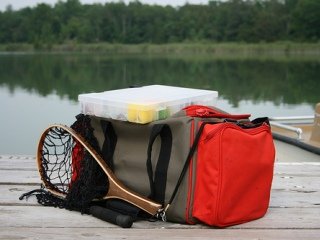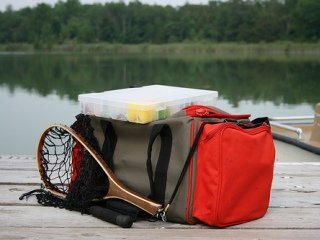 Like hard tackle boxes, soft bags come in a wide variety of sizes for all fishermen and are designed to transport and organize large amounts of tackle efficiently. They accomplish this task by implementing the use of clear storage boxes to store tackle vertically and maximize the use of space. This design is perfect for experienced anglers who have many small pieces of equipment, as it prevents the tackle from sliding around or falling out of place should the bag tip over or even be turned upside down.
Like hard tackle boxes, soft bags come in a wide variety of sizes for all fishermen and are designed to transport and organize large amounts of tackle efficiently. They accomplish this task by implementing the use of clear storage boxes to store tackle vertically and maximize the use of space. This design is perfect for experienced anglers who have many small pieces of equipment, as it prevents the tackle from sliding around or falling out of place should the bag tip over or even be turned upside down.
Most bags are water-resistant (not water-proof) and even come equipped with additional, object-specific, storage, such as hard molded cases for sunglasses, circular zippered pockets that hold spools of line, labeled pouches for cell phones and keys, and even mesh water bottle holders. Furthermore, to add more comfortable options to anglers, some companies even make backpack style tackle bags, equipped to hold a few storage boxes, as well as any other equipment you may need.
Another nice aspect of tackle bags is the freedom to exchange the standard storage boxes included with other types, to hold specific lures. If you're a crankbait fisherman, you can easily replace a normal 370 box with a crankbait storage box, for example. Also, tackle bags have a number of extra storage in which to stow spinnerbait binders, tools and plastic bait bags. The possibilities really are endless, which is a big selling point when considering purchasing a tackle bag.
There are, however, drawbacks to purchasing tackle bags, more specifically, the larger sizes. Models such as the Browning Tuto, which comes filled with eight 370 storage boxes, can be very uncomfortable to carry when those boxes are filled, even with the ergonomic shoulder strap. Believe me, I know from experience. I suggest using large models to store your tackle or take them with you on long trips, and for short, day trips, pick what you need from the bag and put them in a storage box. I personally use Plano's Guide Stowaway box in the 370 size, which is a double-layered box that takes up no more room than a standard 370 box, holds more than enough lures, and fits very nicely inside a backpack.
Finding the right tackle box can be an overwhelming experience if you don't first decide what exactly you'll need to store. Occasional anglers will undoubtedly find the organization and presentation of hard boxes convenient and user-friendly, while those fishermen with more equipment to stow will lean towards buying a tackle bag for its numerous compartments. It's important to take the time and consider what you like to use and inspect every nook and cranny of a prospective purchase before making a decision. Try not to be too amazed at the features and instead ask yourself if you'll ever utilize them. Keep a firm grasp on what you need and maybe what you'll be purchasing in the future. Ultimately, though, you'll want to go with what feels comfortable and what matches up perfectly with your style and level of activity.
For information on hard tackle boxes, make sure to read part one of this story.








